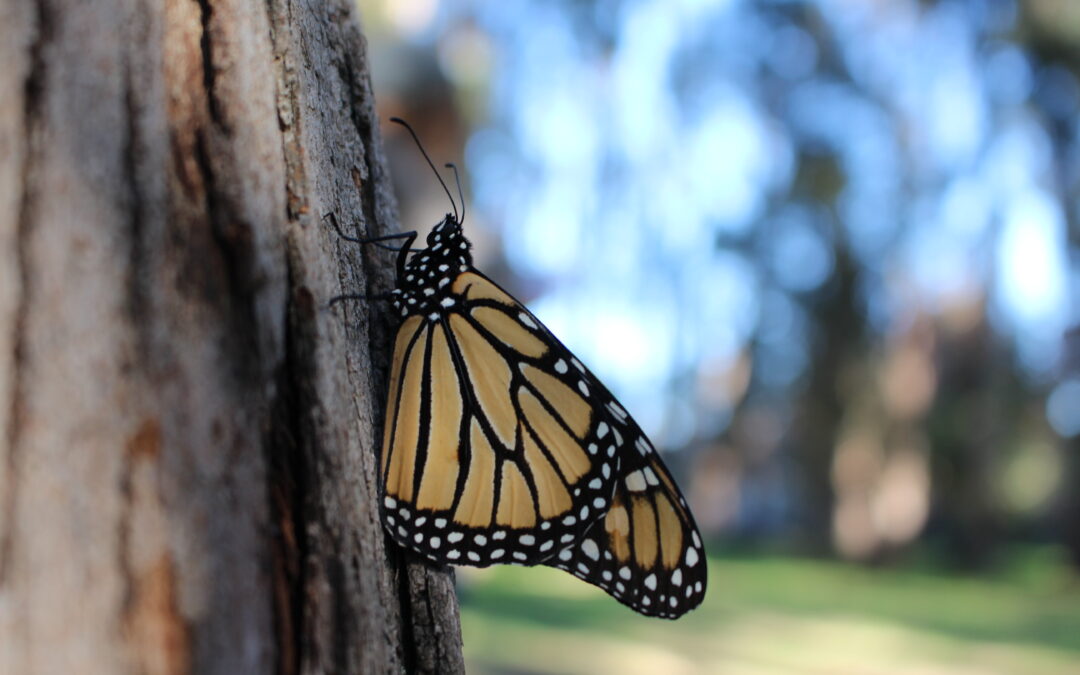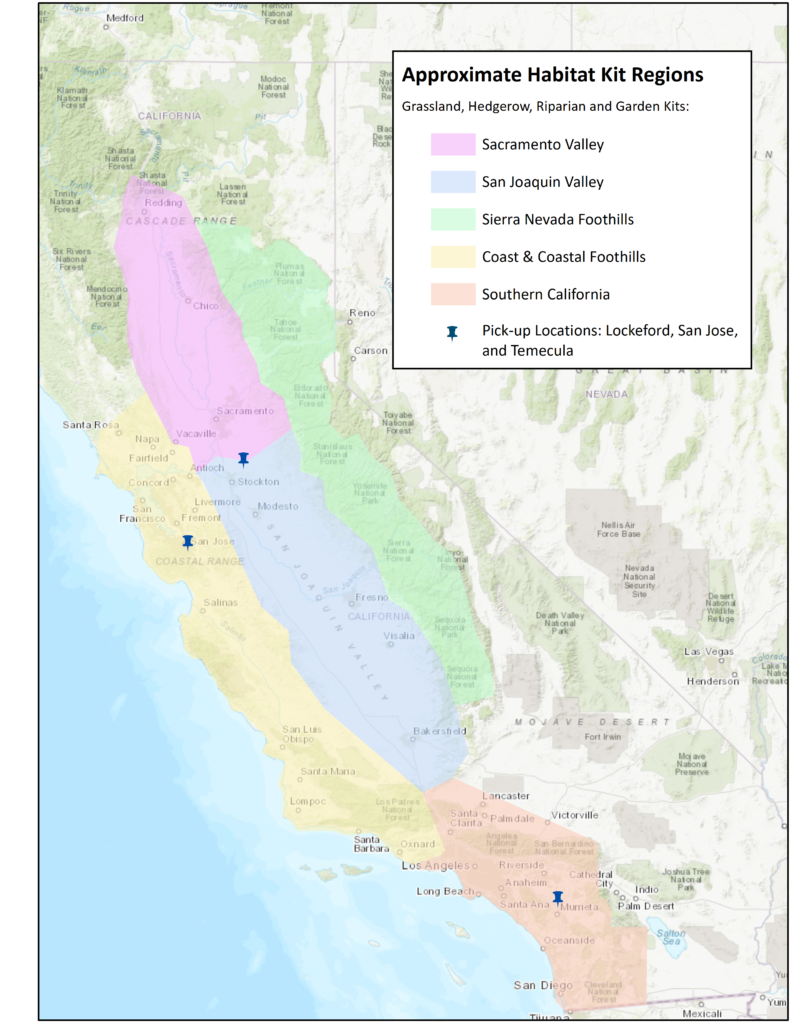MONDAY, FEBRUARY 26, 2024. BY XERCES SOCIETY.
Many pollinating insects are declining in California, including bees and butterflies. The population of Western monarch butterflies has declined 95% since the 1980s, due to a variety of reasons, including habitat loss and degradation, some types of pesticide use, and climate change. One important step we can take to protect these important animals is to increase the amount of habitat available to these species. Xerces Society habitat kits provide climate-smart native plants to project partners who are willing to provide the time, labor, and land to develop pollinator habitats. We are excited to inform you that our 2024 Habitat Kit season has launched!

Between 2019 and 2021, Xerces’ California Habitat Kits provided over 100,000 plants to 144 partners in California, resulting in acres of new, high-quality habitat for monarch butterflies and pollinators.
WHO CAN APPLY?
Kits are intended to be used to create or enhance monarch and pollinator habitats on working lands, public lands, tribal lands, and private/non-working lands recovering from wildfires, with landowner or land manager collaboration. This includes farms, ranches, tribal land, post-wildfire recovery areas, urban farms or gardens, city parks, school gardens, or other public areas. The kits are not intended to be used in home gardens. We encourage projects that will benefit historically underserved or underrepresented communities. We have kits available for Sacramento Valley, San Joaquin Valley, Sierra Nevada Foothills, Central Coast and Coastal Foothills, and Southern California regions. If you do not see your region listed, we do not have kits suitable for your region.
We encourage stewards of working lands to partner with organizations or entities that can provide additional technical support for their projects, such as Resource Conservation Districts (RCDs), The Natural Resources Conservation Service (NRCS), or other conservation organizations.
Past applicants or recipients of this program are welcome to re-apply.
HABITAT KIT DISTRIBUTION
Kits will be available for pick-up in late October or early November. You will be provided with habitat kit pick up days and locations if/when your proposal is awarded a kit(s). There will be a range of dates (usually around 4 days) and times when the kits will be available for pick up.
Kit pick up locations are as follows:
- Sacramento Valley, San Joaquin Valley, and Sierra Foothills kits: USDA NRCS Plant Materials Center, Lockeford CA
- Central Coast and Coastal Foothills kits: Our City Forest, San Jose, CA
- Southern California kits: Temecula Olive Oil Company, Temecula, CA
Kit Regions and pick-up locations for California Habitat Kits.
HOW TO FILL OUT THE PROJECT PROPOSAL FORM
The Project Proposal Form collects information about where the kit will be planted, the size of the area, and plans for site preparation, management, and maintenance, as well as plans for pesticide risk mitigation and outreach opportunities, if applicable. This form is your opportunity to demonstrate that your project is well-designed and carefully thought out. A limited number of habitat kits are available and we receive more requests than we are able to fulfill. Participants are selected based on the project information set out in proposals as well as considerations such as location and habitat implementation and management plans. You are responsible for notifying us if the project plans or point of contact change at any time.
Single kits are not designed to be divided into multiple projects, and we are not able to provide partial kits or customized kits for specific projects. Participants must be able to use the entire kit/minimum order in one project but it can be divided up within the area. For example, several plantings within one county park, or several areas on a farm or ranch. If applying for kits for multiple projects, please fill out a separate application for each project.
If you are interested in partnering with Xerces for this project, please complete the form by April 5, 2024. You will be notified by late May 2024 if you will be receiving a kit. Kits will be available for pickup in October/November of 2024. If you have questions, please email us at: centralvalleypollinators@xerces.org. Click HERE for more information.
HABITAT KITS AVAILABLE
We have several types of habitat kits available and the contents of each kit type vary by region. Some kit types are only available in certain regions because we want to work with local plant and seed producers and use local plant ecotypes in our habitat kits as much as possible. All kits are comprised of native plants that have been identified as having high value to monarchs and other pollinators and are grown without the use of certain systemic pesticides that may be harmful to pollinators. You may request multiple kits if needed for your project. Please note that kits are not certified organic.
Wildflower Grassland Kits. This kit type contains 600 small herbaceous transplants (mostly ‘plugs’) including milkweed, flowering forbs, and some grasses. Each kit will cover approximately 5,400 square feet if planted on 3 ft. spacing. Minimum order of 1 kit/project. Additional kits can be requested for larger projects. Available for the Sacramento Valley, San Joaquin Valley, Sierra Nevada Foothills, and Central Coast and Coastal Foothill regions. Please note that this kit is not available for Southern California.
Riparian Wildflower Kits. This kit type contains 600 small herbaceous transplants (mostly ‘plugs’), including milkweed, flowering forbs, and some grasses/sedges. This kit contains plants that do well in riparian areas and can tolerate some seasonal flooding. Each kit will cover 5,400 square feet if planted on 3 ft. spacing. Minimum order of 1 kit/project. Additional kits can be requested for larger projects. Available for the Sacramento Valley, San Joaquin Valley, Sierra Nevada Foothills, and Central Coast and Coastal Foothill regions. Please note that this kit is not available for Southern California.
Hedgerow Kits. This kit type contains 90 woody and herbaceous transplants including flowering shrubs and forbs, milkweed, and native bunch grasses. Each kit will cover approximately 540 linear feet/5,400 square feet if planted on 6 ft spacing. Container sizes range from tree band to 1 gallon. Minimum order of 1 kit/project. Additional kits can be requested for larger projects. Available for all regions.
Riparian Hedgerow Kits. This kit type contains 90 woody and herbaceous transplants including flowering shrubs and forbs, milkweed, and native bunch grasses/sedges. Each kit will cover approximately 540 linear feet/5,400 square feet if planted on 6 ft spacing. This kit contains plants that do well in riparian areas and can tolerate some seasonal flooding. Container sizes range from tree band to 1 gallon. Minimum order of 1 kit/project. Additional kits can be requested for larger projects. Available for all regions.
Garden Kits. This kit type contains 36 herbaceous transplants including milkweed, flowering forbs, and some grasses. Each kit will cover approximately 576 square feet when planted on 4 ft spacing. Container sizes range from tree band to 1 gallon. Minimum order of 1 kit/project. Additional kits can be requested for larger projects. Available for all regions.
If you need assistance filling out the application form, have questions about your project’s suitability, or need to request technical guidance on your project, please email us at: centralvalleypollinators@xerces.org.
ABOUT THE XERCES SOCIETY
The Xerces Society is an international nonprofit organization that protects the natural world through the conservation of invertebrates and their habitats. Our name (which is pronounced Zer-sees, or /ˈzɚˌsiz/) comes from the now-extinct Xerces blue butterfly (Glaucopsyche xerces), the first butterfly known to go extinct in North America as a result of human activities. The Xerces blue’s habitat was destroyed by development in the sand dunes of San Francisco, and the species was declared extinct by the 1940s. For nearly 50 years, we have protected endangered species and their habitats, produced ground-breaking publications, trained thousands of farmers and land managers to conserve habitat, and raised awareness about the importance and plights of invertebrates in forests, prairies, deserts, and oceans. Our key program areas are pollinator conservation, endangered species conservation, and reducing pesticide use and impacts.
In 2020, the Lodi Winegrape Commission’s Research, Education, & Communication Committee contributed funding to expand the Xerces hedgerow efforts in the Lodi AVA to even more willing growers, since the demand for kits exceeded the amount that could be supplied via grant funding and the goals of the project align with those of the Commission. For more information on the benefits of planting vineyard hedgerows, click HERE.
TO SUBSCRIBE OR DONATE, PLEASE VISIT XERCES.ORG
Featured Image: Western monarch by Candace Fallon, Xerces Society.
Have something interesting to say? Consider writing a guest blog article!
To subscribe to the Coffee Shop Blog, send an email to stephanie@lodiwine.com with the subject “blog subscribe.”
To join the Lodi Growers email list, send an email to stephanie@lodiwine.com with the subject “grower email subscribe.”
To receive Lodi Grower news and event promotions by mail, send your contact information to stephanie@lodiwine.com or call 209.367.4727.
For more information on the wines of Lodi, visit the Lodi Winegrape Commission’s consumer website, lodiwine.com.
For more information on the LODI RULES Sustainable Winegrowing Program, visit lodigrowers.com/standards or lodirules.org.




